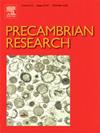Petrogenesis and tectonic implications of Neoarchean mafic and felsic rocks in western Liaoning: Constraints on the crustal evolution of the northeastern North China Craton
IF 3.2
2区 地球科学
Q2 GEOSCIENCES, MULTIDISCIPLINARY
引用次数: 0
Abstract
The late Archean (3.0–2.5 Ga) marks a significant transformation period in the continental crust and geodynamic processes. Representative Archean records in the North China Craton (NCC), including basaltic rocks, trondhjemite-tonalite-granite (TTG) gneisses and potassic granites, are essential for understanding the formation of the Archean continental crust. The Western Liaoning (WLN) in northern NCC preserves valuable Neoarchean geological records, providing a natural laboratory for studing crustal development and geodynamics. Based on mineralogy, petrology, geochronology, and geochemistry, this study investigates the Neoarchean mafic and felsic rocks in WLN. The 2549–2531 Ma old mafic rocks are derived from partial melting of the ultramafic lithospheric mantle, influenced by crustal contamination and metasomatic exchange with subduction fluids. TTG gneisses dated 2526–2509 Ma are classified as peraluminous calc-alkaline granites, generated by the partial melting of garnet amphibolites in thickened arc root. Potassic granites belong to the weakly peraluminous shoshonite-series are S-type granites, originated from partial melting of upper crustal metamorphic argillaccous rocks. This study also identifies a crustal growth episode in WLN between 2.8 and 2.7 Ga, through a comprehensive analysis of Hf model ages of mafic and felsic rocks. Late Neoarchean geodynamic evolution in WLN involved a transition from mid-ocean ridge (N-MORB-type) to intra-oceanic island arc (boninite-type), then to Andean-type active continental margin (adakite-and high-alumina TTG-type), and ultimately to an extensional tectonic phase (the potassic granite-type). Collectively, WLN preserves a complex geodynamic history of crust-mantle interactions related to subduction during the late Neoarchean.
求助全文
约1分钟内获得全文
求助全文
来源期刊

Precambrian Research
地学-地球科学综合
CiteScore
7.20
自引率
28.90%
发文量
325
审稿时长
12 months
期刊介绍:
Precambrian Research publishes studies on all aspects of the early stages of the composition, structure and evolution of the Earth and its planetary neighbours. With a focus on process-oriented and comparative studies, it covers, but is not restricted to, subjects such as:
(1) Chemical, biological, biochemical and cosmochemical evolution; the origin of life; the evolution of the oceans and atmosphere; the early fossil record; palaeobiology;
(2) Geochronology and isotope and elemental geochemistry;
(3) Precambrian mineral deposits;
(4) Geophysical aspects of the early Earth and Precambrian terrains;
(5) Nature, formation and evolution of the Precambrian lithosphere and mantle including magmatic, depositional, metamorphic and tectonic processes.
In addition, the editors particularly welcome integrated process-oriented studies that involve a combination of the above fields and comparative studies that demonstrate the effect of Precambrian evolution on Phanerozoic earth system processes.
Regional and localised studies of Precambrian phenomena are considered appropriate only when the detail and quality allow illustration of a wider process, or when significant gaps in basic knowledge of a particular area can be filled.
 求助内容:
求助内容: 应助结果提醒方式:
应助结果提醒方式:


